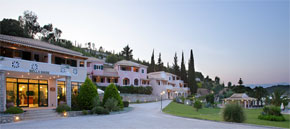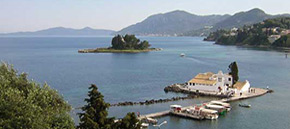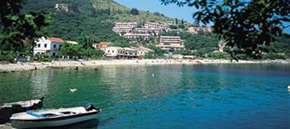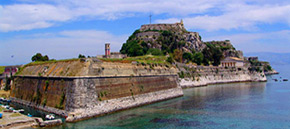- +30 26630 81997
- stay@belmare.gr
Corfu Island
Corfu Island
About Corfu
Corfu is the "Queen of the Ionian islands" of many names and intricate history. It`s the second largest, north and greenest of the Greek Islands. While some areas of Corfu are developed for mass business enterprise since the 1960’s, a lot of the island remains untouched, boasting uninhabited olive groves, picturesque mountains and landscapes full of woods, similarly as a number of the beast beaches in Greece.
Odysseus stopped where and helpful locals pointed his way in the home.Shakespeare was enchanted by its beautiful green olive groves, which he described in "The Tempest".Durrell inspired by its "mouth-watering landscapes" has dedicated her one of his books.
Powerful ruler Napoleon, Empress Sissi, Kaiser Wilhelm II appreciated its qualities and they have honored it with their visit. Here James Bond saved the world from oppression, and Prince Charles plays sometimes cricket. It`s wonderful climate, and beautiful nature and hospitable inhabitants make Corfu, one of the most popular destinations in Greece.
Corfu features a population of roughly a hundred and fifteen thousand people, of that forty thousand live in the city of Corfu, the island’s stylish capital.
It is set fantastically on the East Coast foreland of the island and flanked by the new and old fortresses;French, British, but particularly Venetian influences are apparent throughout the town. Legacies of these administrations can be seen in the “Liston”, modeled after Paris’ Rue de Rivoli the “Spianada” (Esplanade) where the green is home to Greece’s only cricket ground and generally throughout the town the pale pastels of shuttered dwellings in the narrow 18th century streets, have been compared more with Venice or Naples rather than any other Greek town.
The island covers an area of 592 sq meters, with gentle, rolling hills in the south and rugged limestone mountains to the north, where Mt Pantokrator reaches 906m at its highest peak. The mild climate and heavy rainfall (the highest percentage in Greece) encourages the abundance of wild flowers, cypress trees, herbs and other flora and fauna. Due the rich vegetation and suitable climate the island’s main source of income is agriculture. On the other hand the beautiful scenery attracts many visitors, thus increasing the revenue from its tourism trade. Corfu is widely regarded as the nation’s most beautiful island.
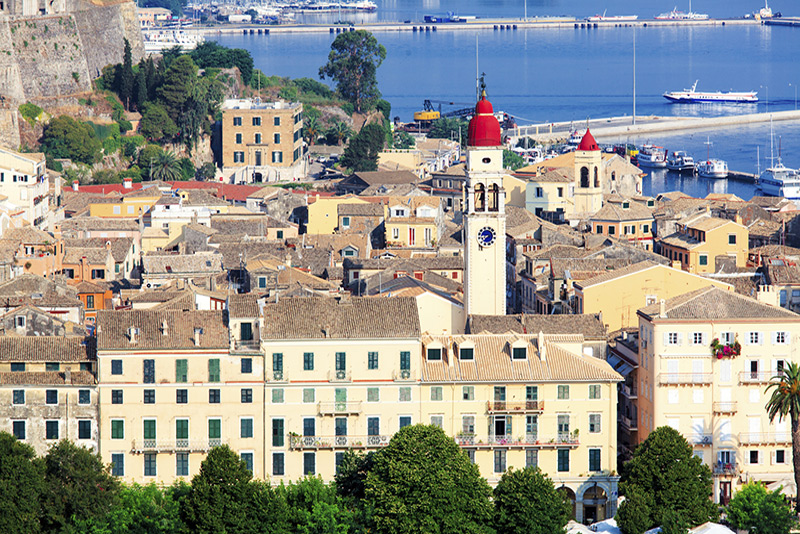 |
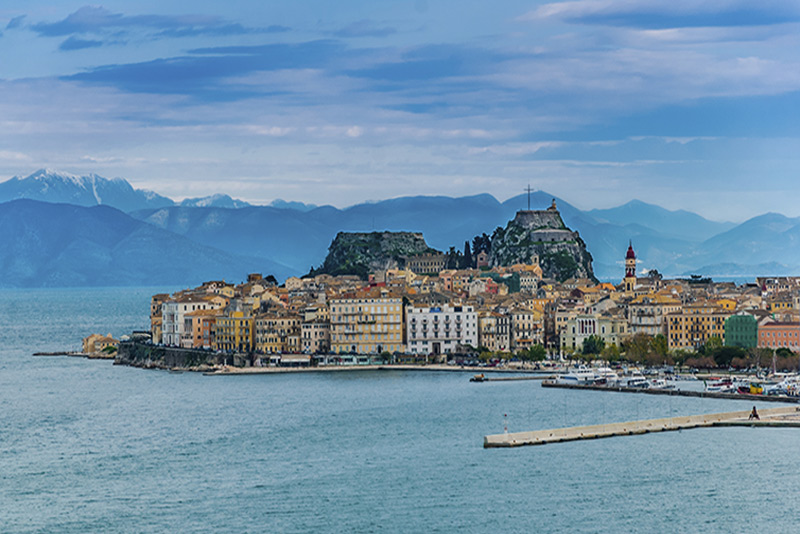 |
Out And About On Corfu
If you would like to discover a bit more of Corfu, here are a few places that you could visit:
Achilleon Palace
This imposing palace, set up high on a hillside south of Corfu Town, was built for the Empress Sissi of Austria. Fascinated with Greek Mythology, she named the Palace after the hero Achilles, and decorated the beautifully landscaped grounds with statues of the Greek heroes and heroines. Built in the early 19th century, the Palace was more recently used under the guise of a casino in the 1977 James Bond film “For Your Eyes Only” (much of which was filmed in Greece) and its grounds make for a pleasant visit, especially on a clear day when the view is breathtaking!
Agios Spyridonas
Tucked away in the maze of Corfu Town’s narrow streets one can find the church of Agios Spiridonas. St. Spiridon is the patron saint of Corfu, accounting for the confusing number of native men named Spiros! Of the many miracles he is said to have performed, a significant example is the story of his placing an invisible barried around the island, making it impenetrable and thus repelling an invading Turkish fleet. In typical Greek orthodox style, the atmosphere inside the church is impressive and dramatic, milling with Greek people who come to light candles and kiss the icons. St. Spiridon’s casket is still kept here, and is the central focus of parades during important religious festivals, such as Easter and the Panayia festival.
Angelokastro
The castle belonging to nearby Paleokastritsa never fails to impress, with its stunning views. Perched dramatically on the edge of the cliff, the castle itself and the vista across the open sea will capture your attention.
Kalami
This village, found off the coastal road on the North-East of the island, was beloved by the Durrell family, where they lived at the White House (their summerhouse). Of the famous brothers, Lawrence wrote “Prospero’s Cell” while actually staying at Kalami, and Gerald drew on his happy memories of the place to write his children’s classic, “My family and Other animals”. Because of this claim to fame, Kalami can become quite crowded in the high season, but nonetheless has a lovely beach, as well as that all-important literary connection.
Kouloura
This exceptionally pretty little harbor is one of the most photographed spots on the island, for which the viewing spot, up on the coastal road, can testify! In Greek the word “kouloura” means ring, and accordingly the harbor itself curls round almost into a perfect circle. A small beach and taverna make this a great stop off point on a day out-possibly cruising along the coast in your own boat.
Mon Repos
Another stately home, Mon Repos was the former residence of the Greek royal family, and birthplace of Prince Phillip. The neo-classical building and its grounds can sometimes be seen from the air when arriving on the island.
Mount Pantokratoras
Corfu’s highest peak stands proudly across the North end of the island at 906m, and the fresh mountain air can prove a welcome relief on a hot summer’s day. Blanketed in olive groves, and studded with the distinctively Ionian cypress trees, many different species of flora and fauna can be spotted in abundance, changing throughout the season. April and early May see the mountain in a riot of pink, due to the flowering Judas trees, while during late May to June it is dressed in yellow, when the Spanish Broom blossoms. Throughout the high season, the hillsides remain astonishingly green, despite Corfu’s sunny climate. This is due to the high rainfall the island receives in the “low” summer season and winter months. The roads over the mountain are surprisingly good, and the numerous picturesque villages one comes across still give a charming impression of traditional Greek life.
Old and New Fortress
Since the sixteenth century, Corfu Town, the island’s capital, has had its skyline punctuated by the old and new fortresses. Despite their names, they were built only 200 years apart and, over the years, several of their parts have been modified by occupying rulers. Whereas once they were used as defenses against the many invading forces that threatened Corfu, these days they are more likely to face invasions of crowds on summer evenings, to listen to the live music concerts that are put on there, often featuring some of the biggest names in Greek music. Open from 9 am to 7pm during the summer, these two striking landmarks are well worth exploring should you decide to spend the day in Corfu town.
Paleokastritsa
The rugged, dramatic scenery of the island’s west coast is home to Paleokastritsa. This popular resort consists of two sandy beaches separated by a headland of rock, and is reached either from the south via an inland road, or from the north by taking a scenic route through mountain villages. With cafes and taverns aplenty, this ever-popular destination is just right for a day trip.
Palia Perithia
Part of the appeal of this mountain village is the route leading up to it, which takes you over the olive-clad foothills of Mount Pantokrator. At the top of the mountain, you’ll find Palia (or Old) Perithia, which was once a Byzantine settlement. The village has been abandoned by its inhabitants relatively recently (allegedly due to feuding in the community), and has since been referred to as a “ghost village”. It offers great views across the mountain and is popular among walkers visiting the island. However, as you make your way up to the village, you will find that some of the old properties are being restored; the village itself is being redeveloped and a several taverns are on hand to greet you upon your arrival. These taverns, frequented by locals during the weekend, offer reasonably priced home-cooked meals.
Pelekas
Pelekas, a popular and pretty inland village on the west of the island, was the favored destination of the Austrian Kaiser Willhelm II. The “Κaiser’s throne” viewing tower is set on a natural ledge overlooking central Corfu, Ropa’s Valley, Corfu Town and much of the Ionian Sea. It is said that from this spot – the mountain peak of Peleka - , one can enjoy the most beautiful sunsets on Corfu.
Museums
The Archaeological Museum
Just a stone’s throw away from the seafront off the Garitsa coastal road near the Maitland Rotunda, is the Archaeological Museum, on Vraila Street, considered by many to be the best museum in the Ionian Region. The main attraction housed here is the 17-foot long west pediment of the Temple of Artemis, originally located in Paleopolis just outside Corfu Town. The pediment is exhibited in the aptly-named Gorgon Room and is embellished with carved figures of panthers and various Gods, whereas the central part is dominated by a haunting Gorgon figure. Other attractions include a stone sculpture of a crouching lion, believed to date from the 7th c. BC and a copy of the famous Athenian statue of Apollo Parnopios. The entrance fee is approximately 3€.
The Byzantine Museum
This small but fascinating museum is housed in an old church; appropriately so, given the fact that the collection features Byzantine and Christian icons and artifacts. Original frescoes can be seen on the walls, dating as far back as the building’s early days in the fifteenth century, whereas inscriptions can be made out on some of the flagstones, bearing the names of those buried underneath them.
The Palace of St Michael and St George
The Palace, built between 1819 and 1824, is a site worth visiting in itself. It served as the residence to the British High Commissioner and as headquarters of the Order of St Michael and St George. Impressive to enter, it is set out on three levels and the main building constructed on the three sides of a rectangle. Two ground floor wings adjoin the central building by two archways and an imposing row of pillars – thirty – two columns in all. The central hall is adorned with rows of ionic columns and framed wall paintings depicting scenes from the Odyssey. A grand staircase leads to the first floor hall, from which three state rooms are accessed. The beautifully spherical “rotunda” was used as a ballroom. The throne room is found on the left-hand side, the state dining room on the right. The two wings located behind these rooms used to be the private chambers of the High Commissioner and today house the Museum of Asian Art.
The Museum of Asian Art
The Museum of Asian Art is housed in the palace of St Michael and St George. It houses a vast collection of over ten thousand pieces of both Christian and Asian works. Over a fifty year period, donations from various benefactors ensured that many other collections were acquired. During the 50’s and 60’s several smaller collections including Chinese furniture, pottery, paintings, Chinese and Japanese porcelain artifacts and three Persian carpets were also bestowed on the museum.
In 1974 a collection comprising of around 450 works from Korea, Japan, Nepal, India, Pakistan and Siam was obtained. It was due to the acquirement of this specific collection that the original name, the “Sino-Japanese Museum” (bestowed in 1927) was altered to the name “Museum of Asiatic Art”. The Christian section on display includes early Christian architectural sculptures and parts of mosaic floors from the Paleopolis basilica, parts of frescoes dating back to the Byzantine period spanning from the 11th to the 18th centuries, which were taken from the ruined church in Kato Korakiana and a collection of 16th and 18th century icons.
The Solomos Museum
The Solomos museum is situated in the Mourayio Area of Corfu Town. It was created in 1864 by the Corfiot Studies Society and displays busts, portraits and other belongings of the poet Dionysios Solomos, taken from the house where he spent the last years of his life.
Museum of the fighters for Heptanesian Independence
Portraits of presidents, other political individuals of note, parliamentary meeting minutes, numerous resolutions favoring the Union, documents dating back to the time of the British Protectorate, newspapers from the period between 1848 and 1864 and other documents referring to the Heptanesian struggle are all housed in the restored Ionian Parliament Building.
Other places of interest
In the Municipal Gallery of Kato Korakiana visitors can view interesting old maps, portraits of the Greek Monarchy and some paintings by Corfiot artists. The Antivouniotissa Monastery houses an excellent collection of paintings and interesting icons. To get a feeling of life as it was in the days of antiquity on the island one can visit the Historical Folklore Museum in Siranades, located on the west side of the island, not too far from Agios Gordis.
Coves and Beaches
Corfu is an island of contrasts in many ways, and its beaches are no exception. The following list is not exhaustive; part of the fun is getting out and about, discovering your own favorite beach!
Kerasia
This pebbly beach on the East Coast reflects well on the nearby Rothschild Estate – with its crystal clear waters, it is great for snorkeling and is in a sheltered position; the one tavern right on the sea contributes into making the place, one of the most idyllic spots on the island.
Kalamaki
Kalamaki is somewhat of a rarity for the North-East Coast, as it is a sandy beach. Its shallow rake, which warms the water for a good 50 meters or so, makes it a great spot for families. There is one tavern up on the hillside overlooking the bay, where one can enjoy a variety of Greek dishes for lunch or diner.
Nissaki
The region of Nissaki is rather reminiscent of some areas on the Pelion Peninsula (on the Greek mainland). It is a small pebbly cove, protected by the mountainside stretching up behind it. It is worth being there a little bit early in the day in order to pick a spot on the small beach. A couple of beachside taverns and a few more situated further up the hillside make this more than just a very pretty spot on which to stop off and enjoy a swim.
Avlaki
A wide sweeping bay with two taverns on the beach offering a choice of Greek dishes and boasting its own resident Windsurfing and Sailing School; Avlaki is great for blowing the cobwebs away with its cool breezes and stunning views.
Peroulades
Another of the West Coast’s famous sandy beaches, this one is set apart from the rest by the bars located way up on the cliff overlooking it; Peroulades also known as “Sunset Beach” is a really fabulous place to watch the sun go down.
Agios Georgios
This long, straight beach is made up of shingle; it is situated between two cypress-studded headlands and is relatively quiet -compared to other beaches on the West coast.
Agni
While it is undeniably as pretty as many of the beaches in this region, the main attractions at Agni are the three excellent taverns. Visitors can arrive there by car, or dock their boat at one of the jetties or even use the taverns speedboat services.
Barbati
The resort of Barbati, while not particularly quiet, boasts a superb beach located a good 100m downhill from the main road and its hustle and bustle of taverns, café bars and shops. During the high season this is one of the busiest East Coast resorts, nonetheless it is also one of the most beautiful.
Longas
Longas beach is popular among the Greeks during the holiday period in August. With the exception of this particular period Longas beach is relatively quiet and one of the most attractive beaches on Corfu. It is located near Peroulades and Avliotes, it is over one klm long and is set against a beautiful backdrop of red cliffs. There are no facilities on the beach itself but a couple of taverns can be found on the hillside above.
Myrtiotissa
Made famous by its description in Lawrence Durrell’s “Prospero’s Cell”- “perhaps the loveliest beach in the world”- Myrtiotissa, on the West coast, has a lot to live up to. Although it can become very busy during high season, a degree of its original charm is retained, undoubtedly due to the fact that it has to be reached by a footpath-this makes part of the beach a rather popular spot with naturists.
Watersports
By traveling to the busier towns of Kommeno, Ipsos or Sidari, some organized activities can be found, including jet-skiing and water-skiing. Locally in the North-East of the island, a small sailing and windsurfing school can be found on the beach at Avlaki, and offers dinghy sailing, windsurfing hire and tuition. In Kassiopi, ringos, banana rides and pedaloes are all on offer, the small bay here is popular with families and couples visiting the area, and is also frequented by people local to the region.

